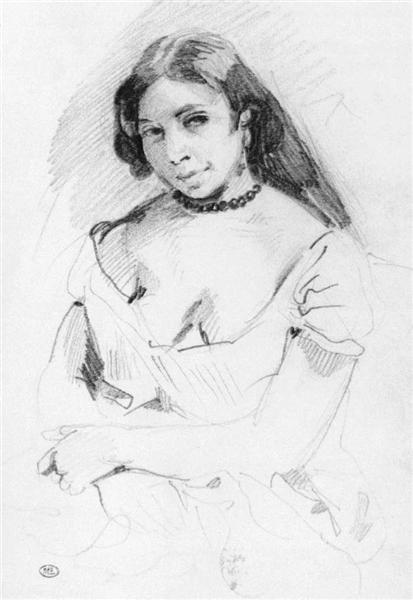Opis
Eugène Delacroix's painting "Aspasia", painted in 1824, is a reflection of the evolution of Neoclassicism towards Romanticism, a movement that eschewed the strict rules of the Academy in search of emotional expression and individualistic representation. In this work, Delacroix captures the essence of the historical figure Aspasia, who, in Greek Antiquity, was a prominent figure of intelligence and persuasion, known for her relationship with Pericles and her influence on the cultural life of Athens. Although the work itself does not illustrate a specific narrative moment, its symbolic charge and the artistic elements that constitute it invite a deep reflection on femininity and wisdom.
Visually, the composition is articulated around the central figure of Aspasia, who is depicted with a thoughtful, contemplative gaze. Her upright posture, leaning slightly to one side, suggests both dignity and vulnerability, a deliberate contrast that resonates with the contradictory character of her figure in the story. The choice of a dark and somewhat hazy background allows Aspasia’s figure to stand out, highlighting her as an almost ethereal presence. This treatment of the background aligns with Delacroix’s romantic tendencies, where the environment can reinforce the subject’s emotion, while also breaking away from the classical academic approach that tended to privilege a more rigid compositional clarity.
Delacroix uses a rich and deep colour palette, with ochres, browns and skin tones predominating, which add a layer of realism to the figure. This colour choice not only emphasises the idea of interiority, but also enhances the sensuality of the female figure, evoking an almost mystical atmosphere. The artist's mastery lies in his ability to breathe life into the canvas through loose brush strokes that lend dynamism to the work. The use of shadows and lights creates a chiaroscuro play that accentuates the forms and adds depth, a technique that Delacroix mastered and that was characteristic of his style.
The figure of Aspasia as a female character is especially significant in a context where women were often depicted stereotypically in art history. Delacroix, by elevating a historical figure such as Aspasia, not only offers a powerful visual representation, but also prompts a re-evaluation of the role of women in history, which coincides with Romanticism's growing interest in individuality and personal experience. This work can be seen in line with other works of its time that explore the psychology of the female figure, as well as paintings by colleagues such as Théodore Géricault, whose work "The Raft of the Medusa" also addresses themes of struggle and resistance by attributing a leading role to individual figures in adverse situations.
“Aspasia” represents not only a milestone in Delacroix’s career, but also a turning point in the depiction of women in art. His ability to capture nuances of emotion and character gives the work a resonance that goes beyond its time, and its relevance remains palpable today. In the story, Aspasia symbolizes the intelligence and power of women, and Delacroix’s work celebrates this figure with a sophistication that continues to challenge contemporary norms about female representation. Through his unique interpretation, Delacroix invites the viewer to reflect not only on the figure of Aspasia, but also on the place of women in culture and history – a question that remains relevant in today’s discourse.
KUADROS ©, a famous painting on your wall.
Hand-made oil painting reproductions, with the quality of professional artists and the distinctive seal of KUADROS ©.
Painting reproduction service with satisfaction guarantee. If you are not completely satisfied with the replica of your painting, we will refund 100% of your money.

